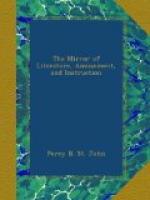The arrangement of the Road Book of Scotland is clear and intelligible, and, moreover, it is a book which may be read in the post-chaise or the parlour, on or off the road, before or after the journey, with equal pleasure. It is so portable, that the pedestrian will not complain of its weight, for it bears the same proportion to an old Road Book that a Prayer Book does to a Family Bible. The picturesque charms of Scotland, and its connexion with eminent individuals, and memorable events of love, war, and chivalric renown, all combine to render a Scottish Road Book attractive and interesting; but the editor prudently observes, that “long descriptions of scenery, except in some few cases, have not been introduced, as they are totally inadequate to convey to the reader any definite idea of the beauties they attempt to portray.” Plans of Pleasure Tours are likewise appended, together with a useful Appendix; and, what is indispensable in a work of this description, a good Index, is added.
As might be expected, nearly every page bears the record of some spot consecrated by hoar antiquity, or in the inspirations of olden or modern genius. Sir Walter Scott has probably monopolized every inch of his native country, and invested each memorable spot with the enchantment of his pen; so that little more than reference is necessary to enable the tourist to identify such sites as the novelist has not distinguished in his writings by actual name. Such information is requisite, for as we are reminded by Kett, who observes, “We are told of a noble Roman, who could recollect all the articles that had been purchased at an auction, and the names of the several buyers. The memory of our travellers ought to be of equal capacity and retentiveness, considering the short time they allow themselves for the inspection of curiosities.” As books and broad-cloth are now bought by the pattern, we cannot do better than substantiate what we have said by a few quotations from the Road Book of Scotland:—
Falkirk.
The view from the hill of Falkirk, immediately behind the town, is remarkably extensive, varied, and beautiful. Hence, the spectator may behold the Ochil Hills, forming part of the ridge which extends from the German Ocean to the banks of the Clyde; and through an opening in the chain for the passage of the Forth, may discover, in fine weather, several isolated rocks, on the highest of which stands Stirling Castle. Beyond, over the Vale of Monteith, appear the Grampian Hills, including the conical-shaped summit of Benledi, as well as Benvoirlich; and further to the west, the lofty Benlomond. To the north are seen the rich valley of the Carse, the Forth, with the towns of Culross, Kincardine, Clackmannan, and Alloa, on the opposite shore, and the country reaching to the foot of the Ochils. To the north also may be seen the village of Larbert, as well as several seats, the most conspicuous of which are Carron Hall, Carron Park, Kinnaird, which once belonged to Bruce the traveller, Stenhouse, the property of Sir W. Bruce, and Dunmore House, belonging to the earl of that name. Immediately below the spectator is Falkirk, and beyond it, the Carron Iron Works. At the further extremity of the valley may be seen the shipping of Grangemouth, and lower down, that of Bo’ Ness.




